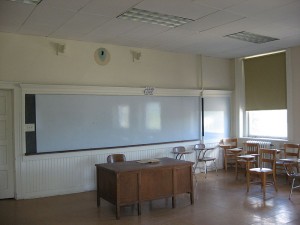One of the most remarkable differences between US schools and those in the rest of the world must be the expense and effort spent in America on competitive sports. A relatively well-off school district in Texas is building a 60 million dollar football stadium seating 18,000, for its high-school. That’s the cost of three separate elementary schools in the district. The bond issue is guaranteed by the Texas Permanent School Fund as a school facilities project, and the entire enterprise paid for in some form by the tax-payer.
This is football crazed Texas, so maybe some perspective is needed. The town’s old stadium was built 30 years ago, seats 12,000 and by all accounts is chronically overcrowded. Presumably, the community derives entertainment value from high-school football games, whose tickets must be cheaper than college or professional games. And this is a well-funded school district, where test scores are above the national and state averages. To most non-Americans it will seem perverse that the school’s football team entertains the community to such an extent. Or that academic budgets wither while sports programs swell across the country.
I also wonder what the average 8th grader gathers from the fact that 18,000 people attend the high-school football game. Do similar crowds show up at the science fair? In stark contrast, the extent to which sports intruded on my life at school in Bombay was the annual “sports day”, a day long track meet at rented facilities. Apart from a weekly P.E. class, and qualifiers a few weeks before the “sports day”, no organized sports intruded on academics.
Undoubtedly participating in sports adds to the educational experience. Competitive sports teach participants the value of effort, teamwork, and strategy. Most adults will rely on these skills much more during their lives than any recollection of elementary calculus. But these admirable qualities can rarely be applied successfully in the world outside of the arena unless students have the rudiments of an education. And does the vast mass of students who are simply spectators absorb these values? All of which should make you pause and wonder whether the focus on sports is sucking air, and resources out of American classroom. Will graduating students be obsessed with televised sport but lack the literacy, logic and arithmetic to function in a service and knowledge based economy? And if that is the case, is the educational system to blame, or the community as a whole?
I recall mid-term tests and final exams every year starting in third grade. Fifth, Eighth, Tenth and Twelfth grade were more important than others since they were considered watershed years. Every examination was intensely competitive. Every test was written and in essay form, I’d never encountered a multiple-choice test till I prepared for the SATs and then it seemed comically easy to have the answer in front of you.
Every term, my parents came in to meet the teachers and collect my report card. As they waited to speak with the teacher and I sat with them, we’d look up at the blackboard and read the names of the top ten students in the class, and their test scores. All the scores were numeric, and there was no where to hide, your parents knew exactly how well you were doing compared to the top 25% of the class. I knew I’d be letting them down if I was too far from the top quartile. It was a brutal, sobering, public assessment of how I was doing. When I look back at it now, that list of the top ten was pretty evenly divided every year between those who had innate ability, and another group who just worked harder than anyone else. Every student knew you could get your name on the board by sheer effort alone.
There is no end to the collection of American movies celebrating success achieved in sport through perseverance. I don’t think it would hurt American public schools to bring some of that drive and competition off the sports-field, into the classroom. Nothing motivates students and parents like a little competition. It would do good to recognize and reward the top ten students every term. In many Asian countries, names and test scores of students who performed particularly well in system-wide tests are printed in newspapers. Parents of these children are justifiably proud, and virtually every child knows it took a lot of hard work to get onto that list. There are drawbacks to be sure, the stress of academic under-achievement can drive some to despair, and many who succeed in structured academics are ill suited for the real world. Yet, on balance the signal sent is that scholarship matters, that academic success is a matter of student achievement and effort, not simply the quality of schools and teachers.
